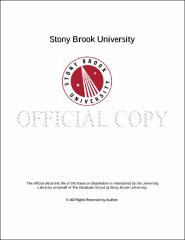| dc.identifier.uri | http://hdl.handle.net/11401/76744 | |
| dc.description.sponsorship | This work is sponsored by the Stony Brook University Graduate School in compliance with the requirements for completion of degree. | en_US |
| dc.format | Monograph | |
| dc.format.medium | Electronic Resource | en_US |
| dc.language.iso | en_US | |
| dc.publisher | The Graduate School, Stony Brook University: Stony Brook, NY. | |
| dc.type | Dissertation | |
| dcterms.abstract | Quantum Chromodynamics (QCD) is the main tool for making precise theoretical predictions for proton-proton collisions at the large hadron collider (LHC). A key lesson from QCD is that physics looks different at different energy scales, under renormalization group evolution. The simplest example is the running coupling, but more examples come from QCD factorization of hadron scattering and effective field theories. A hard scattering event in hadron collisions involves two widely separated scales: the hadron mass scale and the hard momentum transfer scale. The parton distribution functions, describing a light-cone view of the internal structure of a proton, are evolved from the hadronic scale to the hard scattering scale using the DGLAP evolution equation, to set the initial conditions for hard scattering of point-like partons. In more complicated collider measurements, there are more than two widely-separated scales involved, and more sophisticated evolution equations are needed, forming the basis of " resummation" calculations for hadron collisions. We apply threshold resummation and $p_T$ resummation to the production of $W^+ W^-$ boson pairs. Our results, adopted by the CMS Collaboration for experimental analysis, reduced tension between theory and experiment. The production of a Higgs boson in association with a hadron jet is analyzed using the method of effective field theory. The largeness of the top quark mass enables us to integrate out the top quark, which is the assumption behind many theoretical calculations in the literature. But if the Higgs boson is produced with a large transverse momentum, we begin to probe the finiteness of the top quark mass, and possible novel effects beyond the Standard Model of particle physics. | |
| dcterms.available | 2017-09-20T16:51:06Z | |
| dcterms.contributor | Sterman, George F | en_US |
| dcterms.contributor | Schneble, Dominik | en_US |
| dcterms.contributor | Dawson, Sally | en_US |
| dcterms.contributor | Qiu, Jianwei | en_US |
| dcterms.contributor | Paige, Frank. | en_US |
| dcterms.creator | Zeng, Mao | |
| dcterms.dateAccepted | 2017-09-20T16:51:06Z | |
| dcterms.dateSubmitted | 2017-09-20T16:51:06Z | |
| dcterms.description | Department of Physics. | en_US |
| dcterms.extent | 183 pg. | en_US |
| dcterms.format | Application/PDF | en_US |
| dcterms.format | Monograph | |
| dcterms.identifier | http://hdl.handle.net/11401/76744 | |
| dcterms.issued | 2015-12-01 | |
| dcterms.language | en_US | |
| dcterms.provenance | Made available in DSpace on 2017-09-20T16:51:06Z (GMT). No. of bitstreams: 1
Zeng_grad.sunysb_0771E_12451.pdf: 2661644 bytes, checksum: 48c47378d636d4c4eca54d6297d9bad1 (MD5)
Previous issue date: 1 | en |
| dcterms.publisher | The Graduate School, Stony Brook University: Stony Brook, NY. | |
| dcterms.subject | Physics | |
| dcterms.subject | effective field theory, factorization, LHC, particle physics, QCD, resummation | |
| dcterms.title | QCD factorization and effective field theories at the LHC | |
| dcterms.type | Dissertation | |

